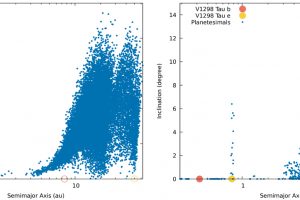Formation and evolution of the complex planetary system of V1298 Tau, described in the study: “The GAPS programme at TNG. XLVIII. The unusual formation history of V1298 Tau” of D. Turrini (INAF – OATo)

The study of the exoplanets orbiting around young stars (e.g., younger than a few tens of million of years) offer the important opportunity for studying the early evoalutionary phases of those processes that shape the architecture of planetary systems. However, it is quite difficult to detect and study exoplanets around young stars, because of their low number, the complexity of their surrounding environment, and their intense magnetic activity which produces signals that can be confused with those due to exoplanets.
A young star hosting a peculiar planetary system lie at a distance of about 360 light years from us, in the direction of the constellation of Taurus. The star is V1298 Tau, it has an effective temperature of about 5000 K, and an age between 10 and 30 million of years. Thanks to observations made with the NASA satellite TESS, it has been discovered that this star hosts 4 massive exoplanets, two of the class of the neptunians and two jovians. The four planets have a very compact configuration, with the farthest having a semi-major axis of its orbit of 0.26 Astronomical Units (1 AU corresponds to 150 million km, equal to the mean Eart-Sun distance), which is smaller than the distance between the Sun and Mercury. The mass is constrained, despite with some uncertainty, for the planets V1298 Tau b (0.64 Jupiter masses) and e (1.23 Jupiter masses), corresponding in densities (1.2±0.45 e 3.6±1.6 g/cm3) which are higher that ne values expected from current planets formation models. These densities require that the two exoplanets formed at large distances from their star, accreting large amount of solids while migrating inward.
The team led by the astronomer D. Turrini (INAF – Astrophysical Observatory of Turin) has realised dynamical N-body simulations in order to reproduce scenario of the formation and the evolution of the planetary system of V1298 Tau that can explain its compact configuration, the lack of resonance between the planets orbits, and the density of V1298 Tau b and e. The simulations confirm that the two planets formed at large distances from their star, in particular farther than the distance at which the local temperature of the protoplanetary disk allowed the condensation of CO2 (which is the CO2 snow line, which lied at about 6 AU). The simulations suggest that the protoplanetary disk should have been quite massive, with an estimated mass of about 0.1 the mass of V1298 Tau. Later, the two planets migrated inward, accreting protoplanets for a total mass of 90 and 110 Earth masses. The present-day architecture of the planetary system and the lack of resonance can be explained by the interaction with a fifth planets with a bass between 0.5 and 2 Jupiter masses, that can still orbit around V1298 Tau. The study is described in the paper “The GAPS programme at TNG XLVIII. The unusual formation history of V1298 Tau“, recently appeared on the jurnal Astronomy & Astrophysics, and signed also by the astronomers G. Micela and S. Benatti of INAF – Astronomical Observatory of Palermo.
The figure (click here to visualize the entire image) shows the configurations predicted by one of the simulations presented in this study. The initial positions of the two planets V1298 Tau b (red) and e (yellow) are marked with empty (initial orbit) and filled (final orbit) circles. The small points instead indicate the eccentricity and the inclination of the orbits of the planetesimals excited by the presence and the migration of the planets.
Mario Giuseppe Guarcello ( follow mariospiegacose) ( mariospiegacose) ( follow mariospiegacose)
Follow the Astronomical Observatory of Palermo on Facebok and on Instagram
Subscribe the Youtube channel of the Astronomical Observatory of Palermo
